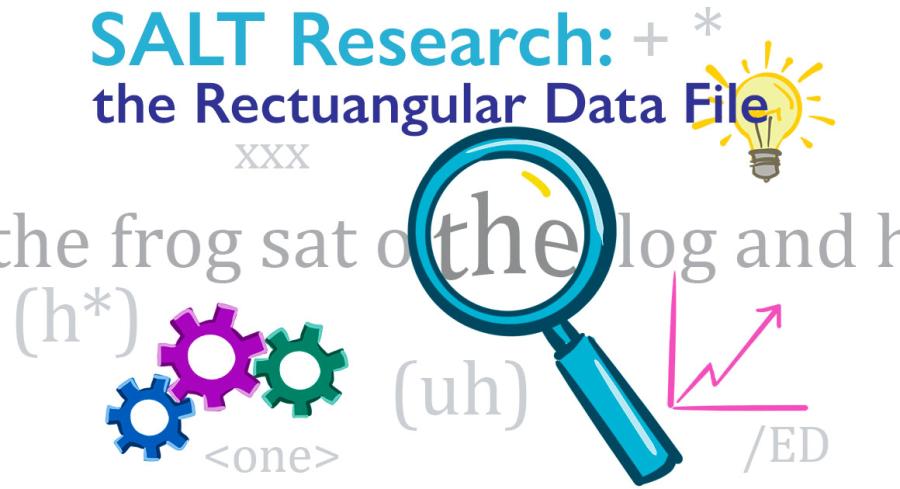
SALT Research: the Rectangular Data File

SALT Research: the Rectangular Data File
Published at: 2021-10-21
“The RDF tool has helped my research immensely. I can quickly generate pilot data from a dozen samples or efficiently compile data from hundreds of samples at the end of the project. The tool exports data in spreadsheets compatible with the main software tools that I use, so I never have to worry about compatibility or converting to different formats.”
John Heilmann, Ph.D., University of Wisconsin- Milwaukee
While SALT is used quite a bit in the clinical world, the research version of SALT provides researchers with a method to analyze large data sets in a way that is easy to analyze.
As part of my job working at SALT, I am fortunate enough to work with researchers using SALT to analyze large sets of data. One essential feature of the research version of SALT that can make analyzing your data a breeze is the Rectangular Data File (RDF). The RDF allows researchers to accurately analyze data in a fast and streamlined way by exporting data into formats that can be used in statistics programs. If you are fortunate enough to have the research version of SALT software, then you have access to the Rectangular Data File (RDF) tool. For my money, this is one of the coolest features of SALT’s already impressive functions.
For anyone who works with large datasets, the RDF saves major time and increases accuracy in analysis. It’s a must-have.
Statistics are typically part and parcel of research using language sample analysis. The RDF tool lets you export SALT data in a format that can be read by programs such as SPSS®, SAS®, Excel®, and Access®. Fast and easy!
After years of working with researchers on various projects, one feature of SALT Research that everyone appreciates is that there is no limit to the number of transcripts you can analyze with this tool. It also allows you to select from just one to all of the SALT analysis variables as well as call up the frequency of any word, morpheme, or code.
Whatever variables you’ve chosen are calculated for each transcript independently. But the results are displayed as a rectangular data file that includes one row of data for each transcript. The output is easy to read and manipulate as needed for your specific research project.
Take a look!
From the Tools menu in SALT, I’ve chosen the Rectangular Data File option. SALT walks you through the steps via dialogue boxes as you see in Figure 1 below. It’s super easy. I used the Select Transcripts button to access 11 transcripts saved on my laptop. I wanted measures from the Standard Measures Report so I clicked that option to select my variables.

From my set of transcripts, I wanted to see data on the following measures: Total Number of Utterances, MLU in words and morphemes, the Number of Total Words, and the Number of Different Words. After choosing those variables, I clicked Generate Data and voila! From start to end, this took less than 30 seconds (27 to be exact!).

From here, I can save my data and export to a statistics package. I am an Excel user, so I typically save my outcomes using the CSV (Comma Separated Value) choice as Excel recognizes it - and then I’m off to the races.

Another excellent feature in the RDF is the ability to generate a key that documents the variables you chose, describes the variable (defines the acronym SALT produces), and indicates from which analysis report you extrapolated the measures. This is a savior when you want to get the exact same values from the same (or a different set) of transcripts at another point in time. Below the key displayed from the analysis variables I chose to produce.

For you stats people out there, when saving your results (click “Save” or “Save As” from the file menu), you select “Save as type”. There you have the options displayed in Figure 3. TXT, or Tab-delimited Text, is an option that most spreadsheet, database, stats, and graphics programs are able to import. Open your program of choice, and from there, open the text file you saved in SALT. The import is no problem.
I could sing more praises about SALT’s Rectangular Data File tool, but let’s keep it brief. If you have the research version of SALT, I highly suggest you try out the RDF. If you have language samples with custom coding, call those codes up for analysis. If you have specific words you’d like to view and analyze, pull them up from your set. It’s lightning fast, saving so much time and effort! I couldn’t be without this feature of SALT. For really detailed information and instructions, as well as some oh so soothing vocals from this gal, please check out our YouTube tutorial on the RDF.
No Comments yet. Be the first to comment.